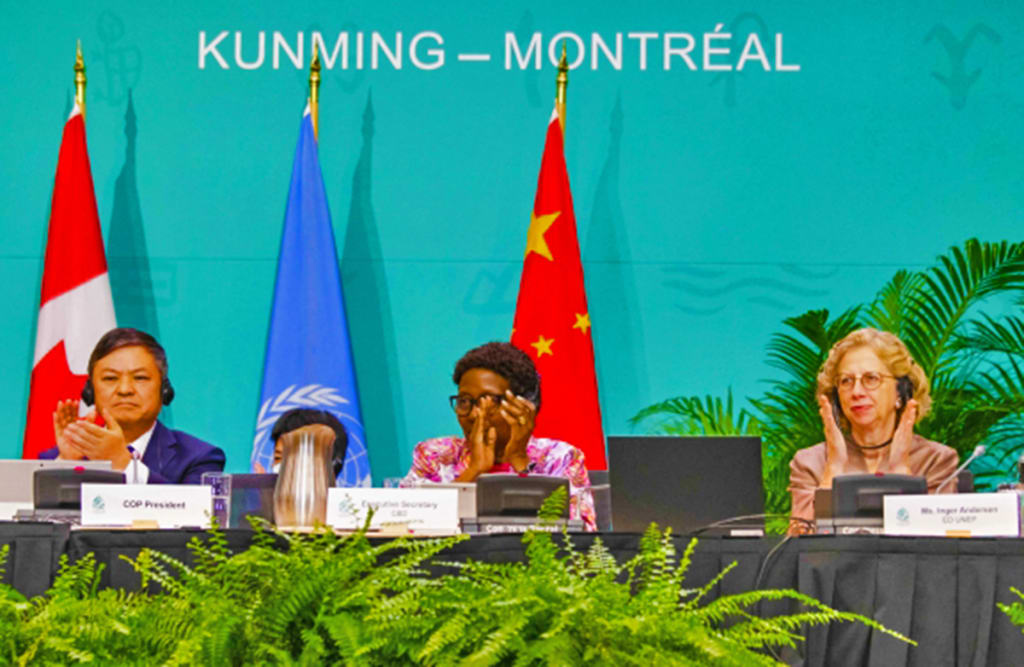BIODIVERSITY CONFERENCE COMMITS TO PROTECT 30% OF NATURAL WORLD
A UN biodiversity conference called COP15 has ended with a deal involving 196 countries. Find out why environmentalists are hailing it as a landmark agreement, and what it will take to put its terms in place.

In grade seven, we took a field trip to the Wye Marsh Wildlife Centre near Midland, Ontario. It consists of 3,000 acres of wetlands and woodlands along the shores of Georgian Bay in the Great Lakes.
We wandered through the marshlands in rubber boots, encountering frogs, turtles and snakes. For most of us, it was our first close encounter with a conservation area.
We spent the night there, and then spent a day at the Ste. Marie Among the Hurons National Historic Site. It’s a recreation of a mission the Jesuits established in the midst of one of Canada’s First Nations in the 17th century.
COLLISION OF SETTLERS, INDIGENOUS PEOPLES AND ENVIRONMENT
The mission’s story is a microcosm of the collision between colonial settlers, indigenous peoples and the natural environment that took place throughout the Americas. It’s a tragedy involving martyrdom, disease and devastation.
Fifty years later, nature conservation and acknowledging the role of Indigenous peoples in protecting the global environment have become more urgent than ever. We’re in the midst of a mass extinction on a par with the events that saw the dinosaurs die out 65 million years ago.
Human activity has transformed three-quarters of our planet’s natural habitat. As a result, over a million species are at risk of extinction this century.
HUMAN ACTIVITY SOLE CAUSE OF SIXTH MASS EXTINCTION
There have been five mass extinctions in the past caused by natural disasters, like volcanic eruptions or asteroid impacts. This time, human activity is the sole cause of an ongoing, sixth mass extinction.
This crisis led my country, Canada, to host the latest UN Biodiversity Conference in Montreal. The plan had been to hold it in Kunming, China in 2020, but COVID-19 forced four postponements.
The UN Secretariat for the Convention on Biological Diversity has its offices in Montreal. Because of the urgency, the secretariat and China’s environment ministry agreed to hold the conference there, with China still presiding over the summit meeting.
COP15 – UN CONVENTION ON BIOLOGICAL DIVERSITY
The United Nations called it COP15. That stands for the 15th Conference of the Parties to the UN Convention on Biological Diversity.
These conferences of the parties, whether on biodiversity or on climate change, have been hit-and-miss over the years. Some have been monumental, while others have been uneventful disappointments.
COP15 turned out to be one of the landmark events. On the last day of the biodiversity conference, at 3:30 in the morning, the 196 member countries agreed to what UN chief Antonio Guterres called “a peace pact with nature.”
“A PEACE PACT WITH NATURE”
The framework’s goals are reminiscent of the targets set in the Paris Climate Agreement in 2017. The exuberant celebrations when officials announced the deal also resembled the revelry in Paris.
They’re calling the deal the Kunming-Montreal Global Biodiversity Framework. It calls for member countries to protect 30 percent of the world’s land, coastal areas and inland waters by 2030, what parties call the “30 by 30 target.”
In addition, the parties agreed to cut global food waste by 50%. The deal “represents but a first step in resetting our relationship with the natural world,” according to UN environment chief Inger Andersen.
AGREED TO RECOGNIZE INDIGENOUS RIGHTS
The framework includes four goals. These are:
The “30 by 30 target” mentioned above
Providing at least $200 billion US annually in biodiversity funding from public and private sources
Reducing subsidies to industries that harm nature by at least $500 billion by 2030
Providing $20 billion per annum from developed countries to developing countries, rising to $30 billion by 2030
The parties agreed to recognize the land rights of Indigenous peoples around the world. This is a groundbreaking acknowledgment, and it’s long overdue.
About 80% of the planet’s surviving plant and animal species exist on land belonging to Indigenous communities. In the past, some conservationists have adopted a misguided “fortress conservation” mentality, driving over 250,000 Indigenous people in 15 countries from their own lands.
STICKING POINTS – NUMERICAL TARGETS AND FUNDING
Colonialism’s legacy created two other sticking points in the negotiations. These were setting the final numerical targets and the need for developed countries to fund the global south’s efforts to achieve those goals.
Developing countries expressed concerns that, in the past, developed countries have set lofty, ambitious goals with no plan to pay for them. At one point, 70 countries from Africa, South American and Asia walked out of the negotiations over the funding formula.
Even so, after some behind-the-scenes conversations, they came back a few hours later. Despite the obstacles, in the end, the parties to the biodiversity conference burned the midnight oil and arrived at a deal with which everyone said they could live.
A FEW COUNTRIES STILL SKEPTICAL
A few countries are still skeptical about the deal. Cameroon, Congo and Uganda protested that China’s environment minister, Huang Runqiu, who chaired the biodiversity conference, seemed to be imposing the deal without taking their issues seriously.
These aren’t formal objections, but they’re potential headaches. Delegates are reaching out to the hesitant countries, especially Congo, to reassure them about their financial concerns.
The trouble with deals like these is always the same. How do we know the parties will hold up their end of the bargain?
HOW DO WE KNOW PARTIES WILL HOLD UP THEIR END OF BARGAIN?
If we base our outlook on the Paris Agreement, the record is discouraging. Despite the widely celebrated Paris target of holding temperature increases below 1.5˚, as things stand, we’re heading for an increase of 2.8˚ by the end of this century.
Here in Canada, we’ve heard endless promises about Indigenous rights, land claims and truth and reconciliation. Yet, despite the good intentions, conditions in Indigenous communities never seem to improve.
So, we have to ask ourselves if COP15’s new “30 by 30” slogan will fare any better than the Paris promises. People around the world will need to hold their governments accountable for realizing goals set at this supposedly historic biodiversity conference.
“WE ARE COMMITTED TO TURNING THIS BLUEPRINT INTO REALITY”
“We are committed to turning this blueprint into reality. We are ready for action,” said UN Development Program (UNDP) chief Achim Steinerhead. “UNDP is there to deliver the systemic changes that can shift the needle on our nature crisis.“
Yet, Mr. Steinerhead concluded by sounding a cautionary note. “One of the most dangerous delusions is that we have a choice whether or not we preserve nature, because the stark truth is that we do not. Today’s agreement is a historic moment in recognition of this truth, and a moment that, if answered with actions as agreed, may set a course for a thriving future on a healthy planet that leaves no one behind.”
We always have more to learn if we dare to know.
Learn more:
UN conference concludes with ‘historic’ deal to protect a third of the world’s biodiversity
Kunming-Montreal Global Biodversity Framework
Safeguarding Biodiversity Means Conserving 44% of Earth’s Land
The Sixth Extinction: An Unnatural History – A Review
WWF Congo Conflict and Fortress Conservation
About the Creator
David Morton Rintoul
I'm a freelance writer and commercial blogger, offering stories for those who find meaning in stories about our Universe, Nature and Humanity. We always have more to learn if we Dare to Know.






Comments
There are no comments for this story
Be the first to respond and start the conversation.